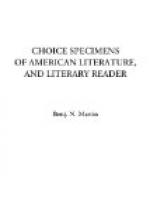There is a picturesque disorder—a lyrical confusion about the entire place, which is perfectly irresistible. Turrets shoot up in all sorts of ways, on all sorts of occasions, upon all sorts of houses; and little boxes, with delicate Gothic windows, cling to their sides and to one another, like barnacles to a ship; while the houses themselves are turned round and about in so many positions that you wonder that a few are not upside down or lying on their sides by way of completing the original arrangement of no arrangement at all. It always seemed to me as if the buildings in Nuremberg had, like the furniture in Irving’s tale, been indulging over night in a very irregular dance, and suddenly stopped in the most complicated part of a confusion worse confounded. Galleries, quaint staircases, and towers with projecting upper stories, as well as eccentric chimneys, demented door-ways, insane weather-vanes, and highly original steeples, form the most common-place materials in building; and it has more than once occurred to me that the architects of this city, even at the present day, must have imbibed their principles; not from the lecture-room, but from the most remarkable inspirations of some romantic scene-painter. During the last two centuries men appear to have striven, with a most uncommendable zeal, all over Christendom, to root out and extirpate every trace of the Gothic. In Nuremberg alone they have religiously preserved what little they originally had in domestic architecture, and added to it....
Nuremberg, like Avignon, is one of the very few cities which have retained in an almost perfect state, the feudal walls and turrets with which they were invested by the middle ages. At regular intervals along these walls occur little towers, for their defence, reminding one of beads strung on a rosary; the great watch-tower at the gate, with its projecting machicolation, forming the pendent cross,—the whole serving to guard the town within from the dangers of war, even as the rosary protects the city of Mansoul from the attacks of Sin and Death—though, sooth to say, since the invention of gunpowder and the Reformation, both the one and the other appear to have lost much of their former efficacy. Directly through the center of the town runs a small stream called the Pegnitz, “dividing the town into two nearly equal halves, named after the two great churches situated within them; the northern being termed St. Sebald’s, and the southern, St. Lawrence side.”
In the northern part of the division of St. Sebaldus rises a high hill, formed, at the summit, of vast rocks, on which is situated the ancient Reicheveste, or Imperial Castle, whose origin is fairly lost in the dark old days of Heathenesse. From it the traveller can obtain an admirable view of the romantic town below. In regarding it, I was irresistibly reminded of the remarkable resemblance existing between most of its buildings and the children’s toys manufactured by the ingenious artisans of Nuremberg and its vicinity.




